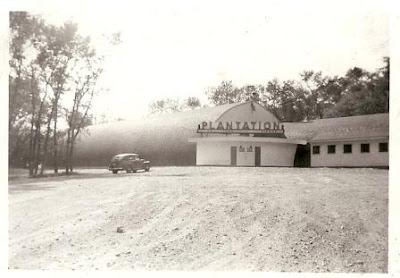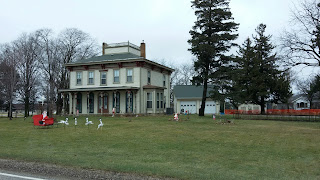Growing up in the 1950s with older sisters
and brothers, I heard a lot about the Plantation Ballroom but don’t remember
ever being there. A few years ago my
mother-in-law shared some photos of the ballroom with me. I came across them again recently and my
curiosity got the better of me—I needed to find out more. While technically located in Palo Alto County
(albeit right on the west side of the road that runs along the dividing line),
I wanted to include the story of the ballroom on my blog because it was enjoyed
by so many Kossuth County residents.
How It Began
H. R. “Hitchy” Pettit and his wife, the
former Elvira Wehrspann, loved to dance.
They attended dances at many different ballrooms while dating and in the
early days of their marriage. They had
been married on June 29, 1934, in St. Luke’s Church at Fairville and settled on
the Wehrspann family farm where they began to raise their family.
Three miles down the road from their home was
a quiet, wooded area which the Pettits drove by frequently. They often commented that it would be a good
location for a ballroom. In the
mid-1940s, the property, which belonged to the estate of Jim Higgins, came on
the market. Despite having five young
children and no experience managing a ballroom or restaurant, the young couple
took a leap of faith and purchased the ten acre tract which included this site
and made plans to build.
The cost to build the 234 x 50 foot structure
housing the ballroom was estimated at $30,000, but by the time it was completed
and fully equipped, the cost had more than tripled to $100,000. No architect for this project – the Pettits
traveled to every ballroom for miles around and listed the best features of
each. Elvira then took a simple tablet
and drew the plans that later became the Plantation Ballroom.
The building contained the ballroom, dining
room, kitchen, a caretaker’s apartment, and a basement used for storage. Glass brick lined the entrance doors. The dance floor itself was made of white
maple and was 60 x 140 feet. It was
lined on the north and south with booths on raised platforms. Modern
fluorescent three-color alternating indirect lighting was installed above the
booths in the ballroom. Just beyond the
entrance were additional booths on two different levels. The grounds included a large parking area and
the Pettits added a trap shooting range and a park for picnickers.
The name of the facility came about as a joke
by the family. Whenever anyone came to
see Hitchy during the construction, he was usually down at the site. The caller would be told that he was down “on
the plantation” and the name stuck.
Due to the isolated location, many persons
scoffed at the couple and nicknamed the site “Pettit’s Folly.” The last laugh was on them, however, as the
facility became a phenomenal success.
Grand Opening
The grand opening took place on September 19,
1948 with more than 1,300 people in attendance.
Elvira, who had only cooked for her family in the past, became adept at
feeding hundreds at a time. Their
reputation for serving great food spread, leading to many large groups
scheduling events. It became a family
affair with all five children working there at one time or another as well as
Elvira’s mother, Clara Fisher, who operated the dishwasher for many years. William Kollasch, a young man who grew up on
a neighboring farm, began working for them at the age of 20 and helped with
management and operation. Over the
years, many community members found work there including high school students
who served as waitresses.
No liquor was sold at The Plantation but that
did not mean it was not present. Patrons
were allowed to bring their own supply and the booths had cubbyholes built into
the underside of the tables in which to store your bottle. They sold 7-Up in what they called “set ups”
for 10 cents. The staff monitored ages
though and didn’t condone or allow underage drinking.
 |
| My husband's grandmother, Susie Kramer, second from right, and her sisters at the Plantation |
The musical talent which played at the
Plantation was well known. Frequent
performers were Elmer Scheid, Spike Haskell, and the Jolly Lumberjacks. Dick Dale sang there many times with the Six
Fat Dutchman. Lawrence Welk played his
last date there before leaving for California where he filmed his very popular
television program.
From Big Band to polka to swing to 50’s rock
and roll – The Plantation Ballroom hosted it all. The dances drew large crowds. Various techniques were used to get the crowd
on the floor and included change-your-partner numbers, dance contests and the
tried-and-true “Hokey Pokey.”
In addition to weekly dances, numerous other
events were held at the Plantation. Senators
Hubert Humphrey and William Proxmire were among politicians who spoke at
political rallies there; style shows, proms, school and club banquets and large
organization meetings also were held at the facility. Of course, it was a popular spot for wedding
receptions and dinners as well.
Fire!!!
Following a Christmas party for 150 for
Weidenhoff Corporation of Algona held on December 16, 1961, the Pettits had
cleaned up and left for home at 1:15 a.m.
Three hours later, a trucker passing by on Highway 18 discovered the
fire and drove to the light plant in Whittemore, reporting the blaze to the
night watchman there. The Whittemore
fire department rushed to the scene, but the entire structure was engulfed in
flames and nothing could be done. It
appeared that the fire had burned inside for some time before exploding through
the ceiling. Highway traffic was lower
that night due to a heavy snowfall which reduced the chances of an earlier
discovery.
Everything was destroyed including an
electric organ and grand piano which had just been purchased. The Pettits were devastated. Although they were insured by Lloyds of
London, Hitchy did not believe it would completely cover the loss. Ultimately,
they decided not to rebuild and so the Plantation Ballroom became a memory. The property is now designated as a wildlife
refuge by the Palo Alto County DNR.
 |
| The Plantation site in 2015 |
Only Memories Remain
As the years passed by, the Pettits continued
their farming operation and their bulldozing and trucking service. They were very active in their church. In 1987 Elvira passed away after an illness
with cancer and Hitchy followed her two years later.
The Plantation Ballroom still holds a special
place in many people’s hearts. It was
there that many young couples met and danced for the first time, including my
husband’s parents, Marvin and Irene (Eischeid) Kramer. If the Plantation had never existed, would they
have ever met? It makes me consider how
different my life might have been.
This post is dedicated to my father-in-law, Marvin Kramer, who passed away December 21, 2015. May he rest in peace.
This post is dedicated to my father-in-law, Marvin Kramer, who passed away December 21, 2015. May he rest in peace.
Until next time,
If you enjoyed this
post, please don’t forget to “like” and SHARE to Facebook. Not a Facebook
user? Sign up with your email address in the box on the right to have
each post sent directly to you.
Be sure to visit the
KCHB Facebook page for more interesting info about the history of Kossuth
County, Iowa.
Reminder: The posts on Kossuth County History Buff are ©2015 by Jean
Kramer. Please use the FB “share” feature instead of cutting/pasting.




















